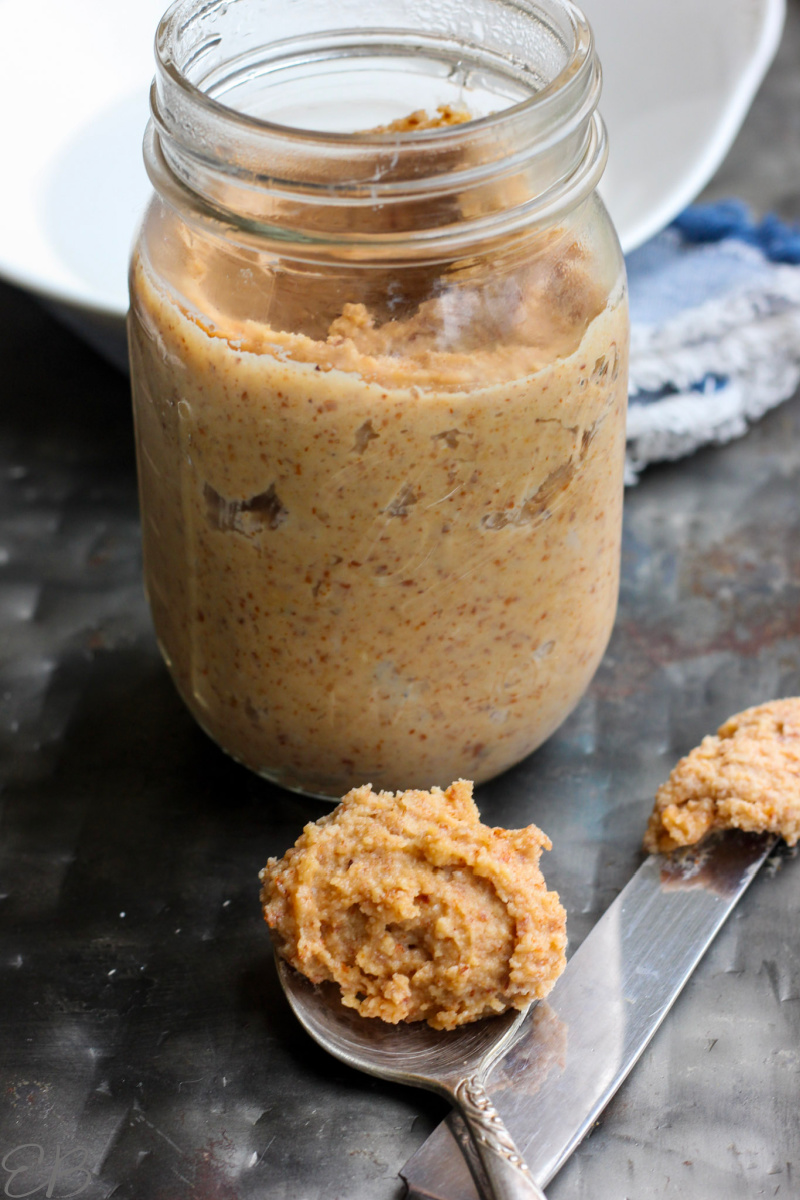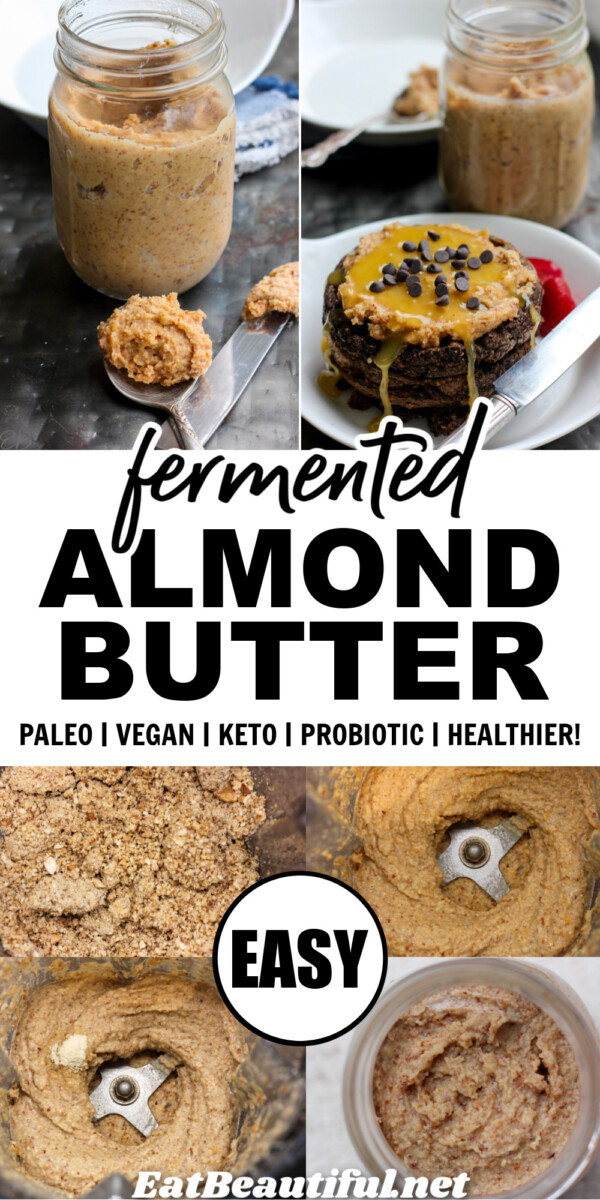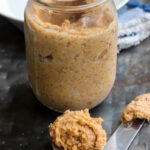I may receive a commission if you purchase through links in this post. I am not a doctor; please consult your practitioner before changing your supplement or healthcare regimen.
Fermented Almond Butter is a delicious, tangy condiment that’s even healthier than regular almond butter. The benefits of fermenting almond butter are: probiotics, fewer anti-nutrients, better digestibility, elimination of any mold, poison or other unseen contaminants and more nutrition from the almonds.
Plus, Fermented Almond Butter makes eating more fun, because it’s adventurous and zippy.
You’ll LOVE how easy it is to ferment almond butter! No special equipment is needed, and it will be ready to eat the next day.
Fermented Almond Butter is great for most diets, including Paleo, Keto, Ancestral, Gluten-free, GAPS and Vegan.

Ingredients in Fermented Almond Butter
- almonds — Preferably raw and then sprouted. But you may also use roasted. See the recipe below for more on how to sprout or “activate” your almonds, if you choose the raw route.
- water — Just a littler water is needed in the ferment to give the probiotics room to move, grow and proliferate. You may also sub the water for a probiotic liquid like water kefir or coconut water.
- sea salt — Optional.
- probiotic — Use a probiotic that is alive and you know works well for inoculating fermented foods, like this one. Or, use a vegan probiotic designed to make dairy-free yogurt.
Skins or no skins on your almonds
You can decide when you make almond butter if you want to remove the skins first or not. This option presents best if you decide to soak and dehydrate your nuts, which is called sprouting or activating them. This process reduces anti-nutrients like lectins and phytic acid.
Most anti-nutrients in almonds are found in their skins, so just soaking to remove the skins in worthwhile.
If you don’t want to remove the skins, the sprouting process is that much more important.
However, a big part of why we’re fermenting is to reduce anti-nutrients — so just leave the skin on, and ferment if you’re not trying to be extra careful.

Variation
Instead of almonds, you may use this recipe as a template: use any other nut and several of the larger seeds, such as sunflower or pumpkin.
How to make Fermented Almond Butter
Making Fermented Almond Butter is super easy and fast:
- Place almonds in food processor. Process until almond butter forms.
- With motor running, gradually add in water until it’s fully incorporated.
- Remove lid, and add probiotic. Blend again just briefly.
- Move almond butter to fermenting container, and cover: This can be a jar, yogurt maker or even an Instant Pot insert, if you have the Yogurt setting on your machine.
- Keep in warm steady location, such as a yogurt maker, seed mat or Instant Pot. (If you don’t have one of these, you can also warm the inside of a thermos with hot water, and use it once emptied again, or place your container in another consistently warm location.)
Your Fermented Almond Butter is ready after an overnight ferment, about 12 to 16 hours. The longer you ferment, the tangier your almond butter will become.
If you want a really lemony spread, ferment for the longer period of time. If you want the health benefits but not an overly tangy almond butter, choose 12 hours.

How and where to use Fermented Almond Butter
Enjoy Fermented Almond Butter in the same ways you enjoy regular almond butter:
But it’s also great for other uses:
- in salad dressings
- whisked with water to make a quick non-dairy milk
- stirred with cocoa/cacao and maple syrup to make a fun, easy ganache
- in sauces, both savory and sweet

Fermented Almond Butter
Equipment
- food processor or high-powered blender
- fermentation vessel jar, yogurt maker or Instant Pot (no plastic is preferred)
- yogurt maker optional, or seed mat, or IP with Yogurt setting
Ingredients
- 2 cups almonds See how to optionally sprout or "activate" almonds in the Notes section below. (I chose to remove the outer husks on about half of my almonds. You can leave yours on or take them off for better digestion and nutrition.)
- ½ cup water or you may also use water kefir; you may use a little more water if your almonds have all their husks (up to ¾ cup; add enough water to have a creamy smooth spread that's still thick)
- ½ teaspoon sea salt optional
- 2 to 3 capsules probiotic depending on size and strength, or Vegan yogurt starter
Instructions
- Place almonds in food processor or high-powered blender (such as a Vitamix or Blendtec). Blend until pulverized into nut butter. Use a wooden utensil to scrape sides into middle.

- Add water, and process again, scraping down the sides once during this time. Process until mostly smooth and creamy. Add probiotic. Blend again briefly.

- Transfer to fermentation vessel or glass jar. Cover loosely. Place in steadily warm location for about 15 hours. (Photo below shows almond butter on warm seed mat. If your kitchen is cold, wrap your jar with a towel. If you have an Instant Pot with a Yogurt setting, you can ferment directly in the insert pot, if you like.) Note: Your almond butter may have a darker "skin" over the surface after fermenting, which is fine; it's just darker and firmer where it was exposed to the air. This can be stirred in or ignored. Enjoy!

- Refrigerate for up to 1 month, or possibly longer.
Nutrition

You can Pin this recipe here:

Similar recipes you might enjoy:
- Fermented Peanut Butter
- Kombucha Overnight Oats
- Overnight Hemp Porridge
- Fermented Nut and Seed Milk (use any nut or seed of choice)
- Overnight Chocolate Muffins
- Dairy-free Fermented Cheesecake
Are almonds healthy
Sadly, conventionally grown almonds have more glyphosate residue than most other foods.
Most have also been treated with propylene oxide gas, which is carcinogenic and banned in Mexico, Canada and all of the E.U.
One more reason why fermenting is healthy
If all you can afford is conventional foods (instead of organic), fermenting is your best friend! That’s because good bacteria transform and destroy toxins!
One other thing to remember when buying almonds, try not to source them from California (unless you buy this sustainable crop).
I know that might sound strange, but two reasons exist: one, California is a dessert, and you wouldn’t believe the way water is fought over in that state to grow almonds … when in reality, they should be grown somewhere else, like where they grow natively!
Secondly, no almonds coming out of the U.S. are actually raw. Pasteurization is the law. You can’t actually sprout or activate California grown almonds, even if they are labeled, “Raw”.
Try buying almonds from Spain, like these.
The last issue to consider when you decide how many almonds you’re going to eat is their fatty acids. As you may know, healthy diets emphasize omega-3 fats. Almonds are the opposite; they’re high in omega-6s. I still enjoy almonds, though. I just make sure to eat plenty of fresh, high quality fish, grass-finished beef (not just “grass-fed”), and I don’t overdo almonds.
Read more here about why most almond butter is bad for you, in contrast to Fermented Almond Butter sourced from natively grown almonds.





Steve Jonas says
Hi Megan,
I have a question for you about fermenting nut butters. Could I ferment a nut butter that I purchase using your method of inoculating the butter with a probiotic? Thanks!
Megan says
Hi Steve, yes, you surely may use store bought. The only reason to hesitate is that so many are a) rancid and/or b) from poorly sourced almonds. (Or, perhaps you are not thinking of almond butter.) I recommend Maranatha brand as they seem to take more care with their sourcing of ingredients and care of them. Or, if you can find a nut butter that you know comes from almonds not grown in California or other nuts grown sustainably (in regard to the water use problems). Ha, so many issues! Put simply: If you find a good nut butter that you feel is well sourced and not rancid, the answer is Yes, you can do it! So, method wise, most jars of nut butter are 16 ounces, which equates to 3.5 cups nuts. So you will need to use more water than the recipe calls for. I believe the conversion gives us 7/8 cup water. So, you can follow this recipe, but instead of adding 1/2 cup water to the 2 cups nuts, you’ll add 7/8 cup water to 16 ounces nut butter. I’d put the nut butter in the food processor or blender and get it going, and then pour the water in slowly with the motor running until it’s fully incorporated. Then, use 3 to 4 probiotic capsules and about 3/4 tsp. sea salt. I hope it’s a fun process for you! 🙂
Steve Jonas says
Thank you so much Megan for your kind and detailed response. I was thinking about other nut butters such as hazelnut and sunflower butter. I love the conversion you did for me on the amounts. Thank you thank you thank you!
Steve
Megan says
You’re welcome and my pleasure! Enjoy!! 🙂
Dorothy says
It’s good to know we can make a healthier almond butter, and you make it seem easy. I have some soaked and dried almonds that have been stored for a while, and now I know what to do with them! Do you think BioKult would work well for the probiotic?
Megan says
Hi Dorothy, yes, and great. BioKult should be fine for fermenting. I don’t know for sure, but it logically should. The last time I purchased that brand the capsules were on the bigger side. If that’s still true, you may just need 1 to 2 capsules, definitely not 3. I’d love to hear how it goes for you.
jennifer says
You have captured this nut butter lover’s attention! I was surprised and excited to read all the benefits above and beyond just getting probiotics and I feel like it’s something the kids would like. Definitely going to make this, thank you!
Megan says
Yay, so glad, Jennifer. Just tell the kids it’s lemony first so they’re not too surprised ;). Enjoy!!
Donny says
So cool! That tangy flavor makes the almond butter so much more interesting. I hardly ever eat yogurt so this is a great way for me to get my priobiotics.
Megan says
Great, Donny! Thanks for sharing, and I’m glad it’s a new good option for you, for probiotics and to pep up your old almond butter flavor! 🙂
Stacey Crawford says
Nut butter can be hard to digest but your method of soaking the nuts and fermenting the nut butter makes the almond butter much easier on the tummy! I actually enjoy that little bit of tang in the almond butter.
Megan says
Great to hear, Stacey, and yes, so true about it being so much gentler to digest. I’m glad you like the flavor!
A says
Hi Megan,
Looks delicious! Thanks for sharing a healthy way to enjoy nuts. I may have missed this in the article, but how do you sprout/activate the almonds? There are so many different methods online.
Regarding Steve’s question, have you found that using home-fermented, store-bought almond butter is ok even without almond skin removal? Is the fermentation enough to help with the phytic acid and oxalates? Also, what are your thoughts on using blanched almond flour to make fermented almond butter?
Does the almond butter really taste lemony? Or is it more of the sourdough tang?
Thanks!
Megan says
Hi A, you’re welcome and happy to help! Toward the bottom of either of these two posts, I have the recipe for how to sprout/activate almonds: https://eatbeautiful.net/why-most-almond-butter-is-bad-for-you/ or https://eatbeautiful.net/how-to-sprout-nuts-and-seeds/
I don’t think that store bought almond butter is a good route for some of the reasons outlined in the first article above: store bought almond butters are usually sourced in California (a thirsty crop grown in a desert is a terrible use of water resources), the nut butter is almost always rancid and oftentimes contains more mold than nuts themselves. That being said, if you find a brand that is sourced from sustainably grown almonds (not just organic, but with water usage in mind), the anti-nutrients in the almond skin would be greatly reduced through fermentation and likely completely reduced after a long fermentation. Regarding using blanched almond flour, I vaguely remember trying it once, and I believe it worked well. I made a small batch in my powerful electric spice grinder, and it was lovely. So yes, sounds like a good idea, especially if you find a well sourced one. I like this one from Spain, if you don’t already have a good source: https://amzn.to/3CFSr9C Re the taste, yes, I do think it actually tastes lemony more than the sourdough flavor! 🙂 I hope you love it, and would love to hear how it goes.
Rachael says
Can you use whey to ferment this almond butter? If so, how much? Thanks!
Megan says
One tablespoon should be enough, and yes, you can. 🙂